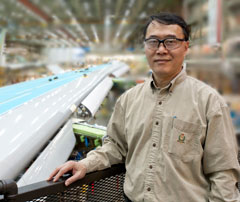 "My baby" is how Jack Peng thinks of the Boeing X-37B orbital test vehicle, an unmanned craft for the Air Force that took its first flight in 2010. He helped design the carbon-carbon hot structure control surfaces for the ruddervator and flaperon while working for an aerospace contractor in Houston. Over 14 years as a specialist in aerospace composite structural design, analysis, and testing, he compiled an impressive pedigree of high-profile, high-flying projects.
"My baby" is how Jack Peng thinks of the Boeing X-37B orbital test vehicle, an unmanned craft for the Air Force that took its first flight in 2010. He helped design the carbon-carbon hot structure control surfaces for the ruddervator and flaperon while working for an aerospace contractor in Houston. Over 14 years as a specialist in aerospace composite structural design, analysis, and testing, he compiled an impressive pedigree of high-profile, high-flying projects.
When he launched his academic career in Taiwan with a BS degree in naval architecture, he never imagined his future work would take to the skies rather than the sea. After service in the Taiwan navy and then civilian work in construction field engineering and materials testing, he crossed the Pacific to earn his master's degree in mechanical engineering and doctorate in civil engineering at Southern Methodist University.
Lockheed Martin hired Peng as a principal engineer in late 1989 to do design and stress analysis and finite element modeling for aerospace structures, including Space Shuttle payload hardware and International Space Station projects. In Houston he subsequently spent two years at Boeing working on structural design and strength analysis for the composite shell of the Delta IV rocket, then seven years at SAIC in structural design, analysis, and testing for the X-37B, the Space Shuttle, International Space Station, a solar powered solar probe, and an X-38 crew return vehicle.
The Boeing Company recruited him to Everett in late 2006 to work on composite wing components and rudder for the new 250-foot long, 747-8, its largest plane yet, with freighter and passenger versions. Even given his long experience and doctoral degree, Peng promptly signed up for three rigorous composite analysis and design courses in a certificate program jointly sponsored by UW Engineering and Boeing Learning, Training, and Development.
"The courses teach the theory behind composites. Dr. Kuen Lin (UW professor of aeronautics and astronautics) started from scratch and wrote equations step by step," Peng said. "After you take the course you become more confident in everything you do. I would learn something in class and apply it the next day at work. If my boss questions why I am doing something, I can explain very clearly."
In 2009 he completed the Aircraft Composite Materials and Manufacturing course, which focused on how composite material is made, its strengths and weaknesses, and repair methods. "The most important thing down the road is composite repair, and that probably will be the next stage of my career," he said.
At present Peng is working on the 747-8 wing edges, using flight load survey data to compare how the parts perform in comparison to theoretical modeling, with a goal to save weight. "It's interesting to see the results and then work with the shop to fix any issues," he said. "If you save one pound in any part, you will save $4000 on fuel costs over the 20-year life of the airplane. Sometimes we try to save even an ounce."
In comparing his aerospace experience with commercial aviation work, he describes space as more adverse due to the temperature challenges, but with fewer worries for unmanned vehicles. "Airplane work is more tedious in regard to load analysis, and more delicate and precise. You need a sharper pencil," he noted.
With the March 20 first flight of the stunning 747-8 Intercontinental passenger jet, Jack Peng has both very sharp pencils and a big new baby.